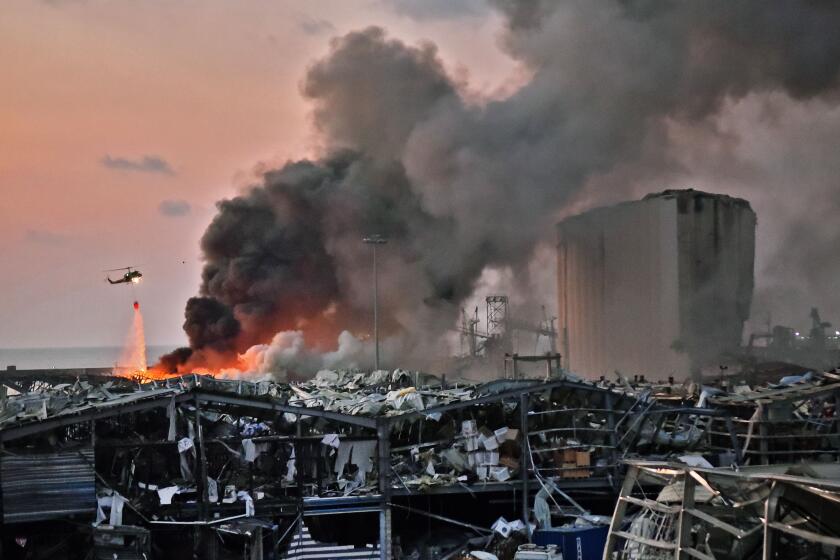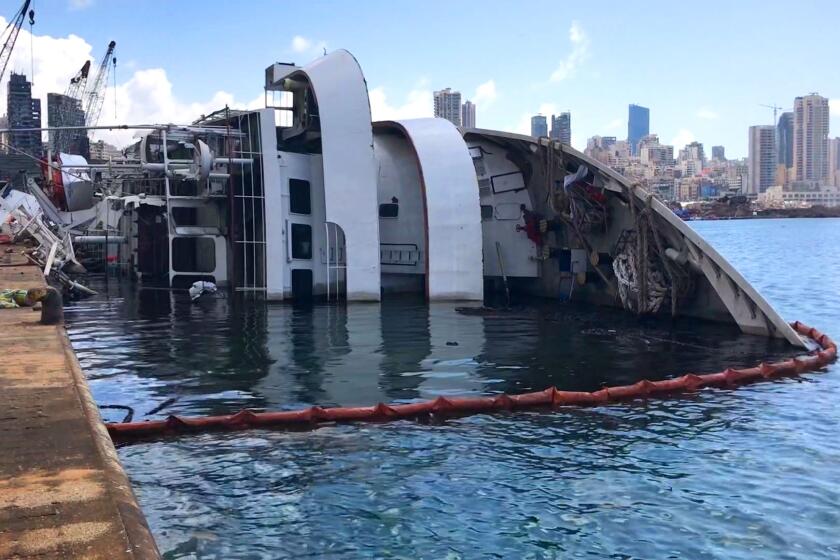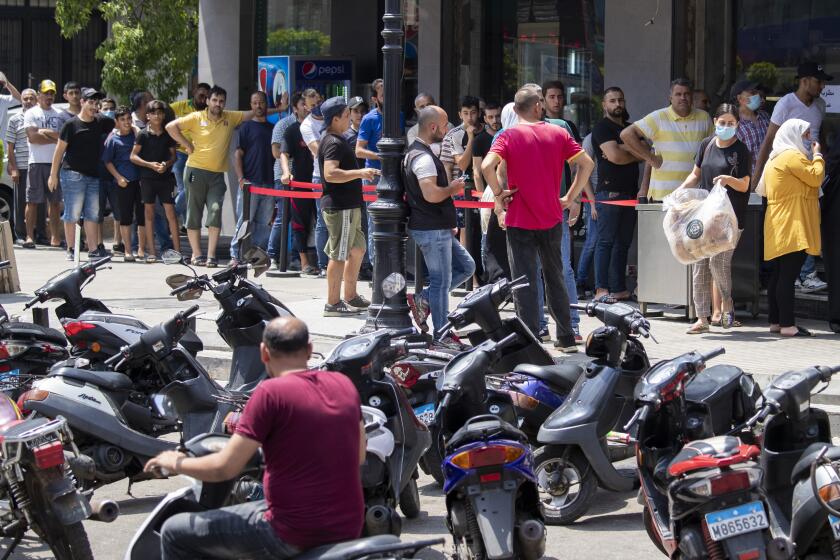
The blast — the third-largest non-nuclear explosion in history — pushed out a fireball miles into the air, followed by a hemispherical shock wave that raced inland for six miles at supersonic speed.
- Share via
BEIRUT — The day Beirut exploded, the silos remained. For 50 years, dozens of white, 157-foot-tall cylinders presided over Beirut’s port and held much of Lebanon’s grain — landmarks in a city that had lost many of them to civil war or pitiless development.
For Lamia Ziade, an illustrator and visual artist, they were the touchstone she would glance at every time she looked out the window of her grandmother’s house on Pasteur Street.
“They were the gate of Beirut. You saw them from the sea, the air, whenever you would go from one side of the city to the other,” said Ziade, 53, who was born and raised in the Lebanese capital and now lives in Paris.
“They were like the pyramids, like the Eiffel Tower of Beirut. Every time I passed them, I would think how lucky we were to have this sentinel, these silos, protecting us.”
A year ago, they did exactly that when, at 6:08 p.m. Aug. 4, 2020, some 2,755 tons of ammonium nitrate carelessly stored in the port’s Hangar 12 exploded.
The blast — the third-largest non-nuclear explosion in history — pushed out a fireball miles into the air, followed by a hemispherical shock wave that raced inland for six miles at supersonic speed. It ripped walls off buildings and transformed houses into deadly cyclones of glass shards and wood splinters. It flicked aside cars, trucks and even a lumbering cruise ship like so many marbles. The disaster left more than 200 people dead, thousands wounded and 300,000 homeless.
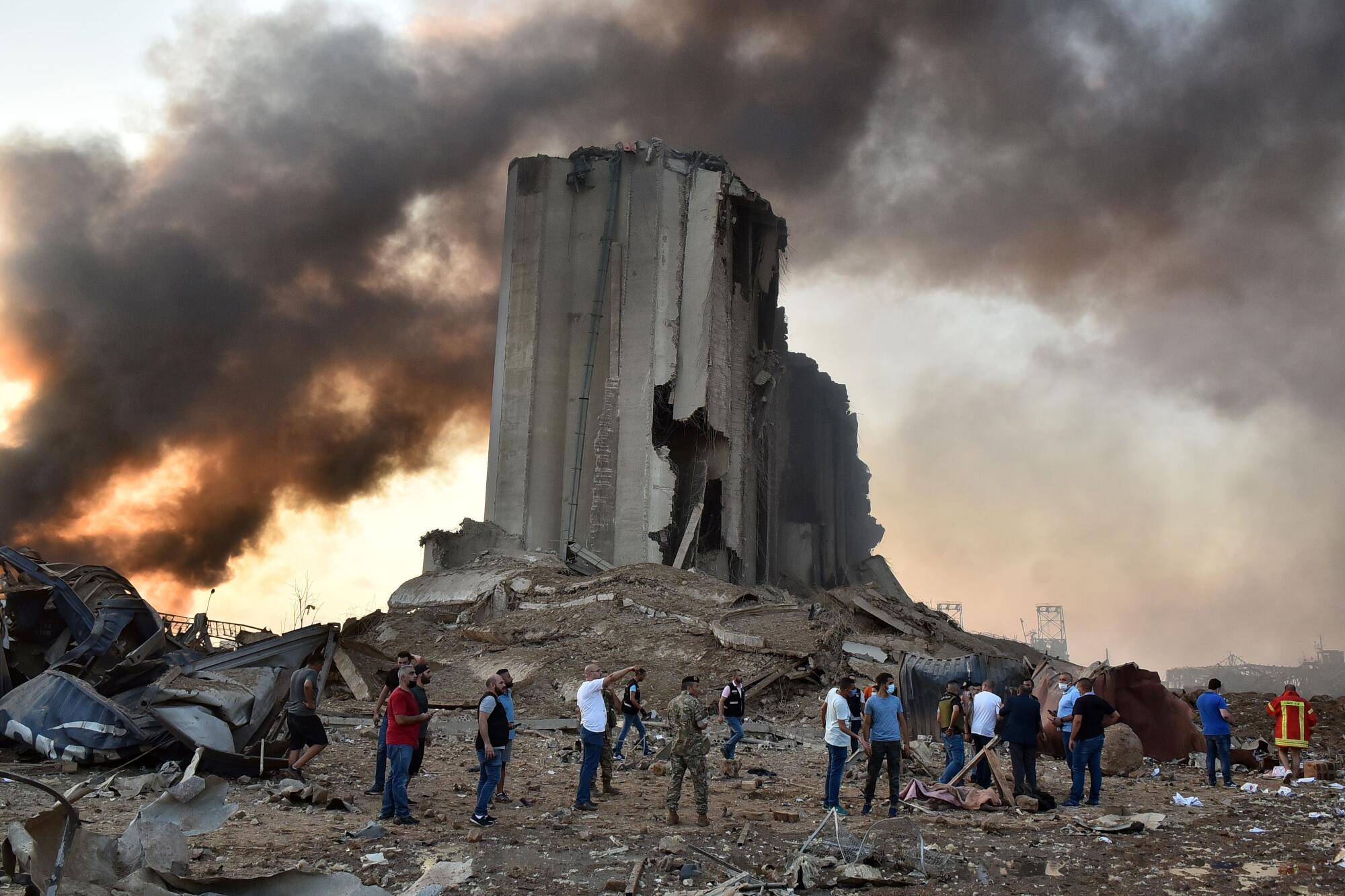
The silos, located less than 250 feet from the blast’s epicenter, acted as a shield for the western part of the city, and stayed standing.
They still do — barely. Leaning more by the day toward the sea, their disemboweled husks now hang, like the country, in a state of slow-motion collapse. And whether to raze or preserve them has raised urgent questions about how best to remember that Tuesday evening and its still-unresolved aftermath.
“People have an emotional connection to the silos. After the explosion, the attachment with the structure increased,” said Gioia Sawaya, a Lebanese architect and researcher.
“With the blast, we lost more than houses and part of our city. ... What is important is not to lose the social relationships and connections that keep us intact as Lebanese. The silos, with the collective memory they carry, are a wakeup call.”
Los Angeles Times reporter Nabih Bulos was less than 500 yards from the center of the massive explosion in Beirut. He lived to tell the tale
For many shell-shocked residents, the silos that were once a symbol of national promise have instead become a monument to the decades of official negligence and systemic corruption that allowed such an enormous quantity of ammonium nitrate — a chemical used in agricultural fertilizer but also in bombs — to be unsafely stored for seven years at Beirut’s port.
“The silos, as a visible structure, were a reminder of how organized and pro-active Lebanon was in its early days,” said Abdul Halim Jabr, an urban designer and member of the Beirut Heritage Initiative, a group of architects and preservation experts.
Now, he said, their meaning had become “tragedy and devastation.”
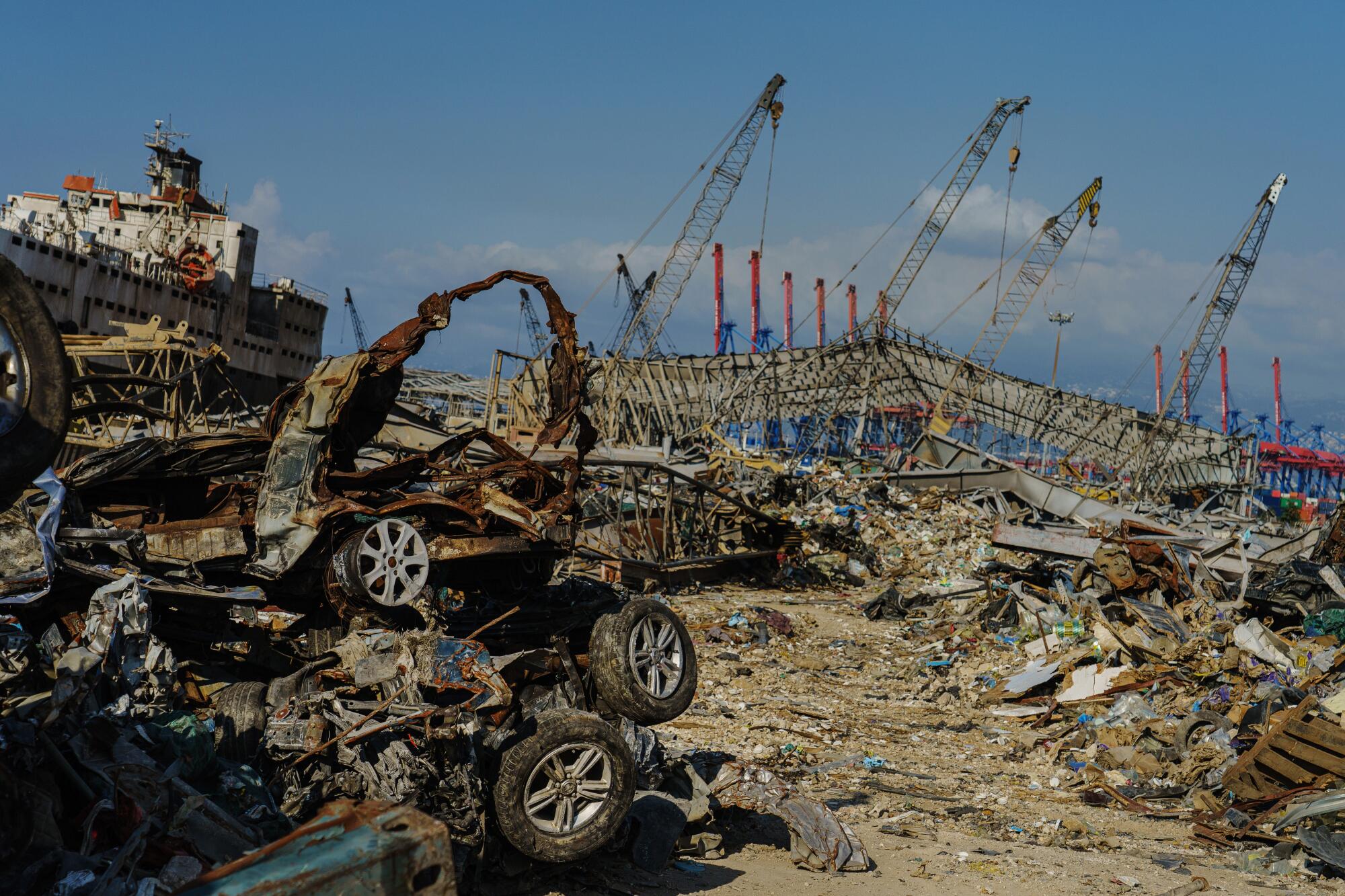
“The silos’ current state of ruin embodies the state of ruin of the entire city,” said Antoine Atallah, an urban designer also working on heritage issues.
Even more than government incompetence, many see the silos — which managed to survive two wars — as a reminder of the lack of accountability and, worse yet, the seeming indifference of Lebanon’s political elite. No one in charge has apologized, accepted blame or even contacted the victims’ families.
“From the top of the pyramid to the bottom, they don’t care. It’s been a year of this. May God burn their heart like they burned mine,” said Yusra Abu Saleh.
Her son, 20-year-old Ibrahim Amin, was a cleaner at the grain silos. But when a fire began in Hangar 12 roughly 30 minutes before the blast, no one warned those still at the port of any danger, including the firefighters dispatched to combat the blaze. Amin was killed when some 30,000 tons of grain submerged him and seven other workers.
Restoring historic districts badly damaged in the Beirut blast will be a tall order given Lebanon’s weak economy and developers’ eagerness to move in.
Despite early promises of swift justice for those responsible, months have passed with the investigation all but stalled. Officials have instead tussled over petty jurisdictional issues, shrugged off investigators’ summons and claimed ignorance of basic facts. (“I didn’t know what ammonium nitrates were” has become a common interview response.)
“My son stayed for five days under the wreckage,” Abu Saleh said. “The Lebanese state did nothing. It was foreign rescue teams who got his body out.”
That feeling of limbo has extended to the silos and their surroundings. The port remains a neighborhood-sized trash pile, a post-apocalyptic diorama of rusted rebar knots and heaps of crumpled containers and vehicle carcasses.
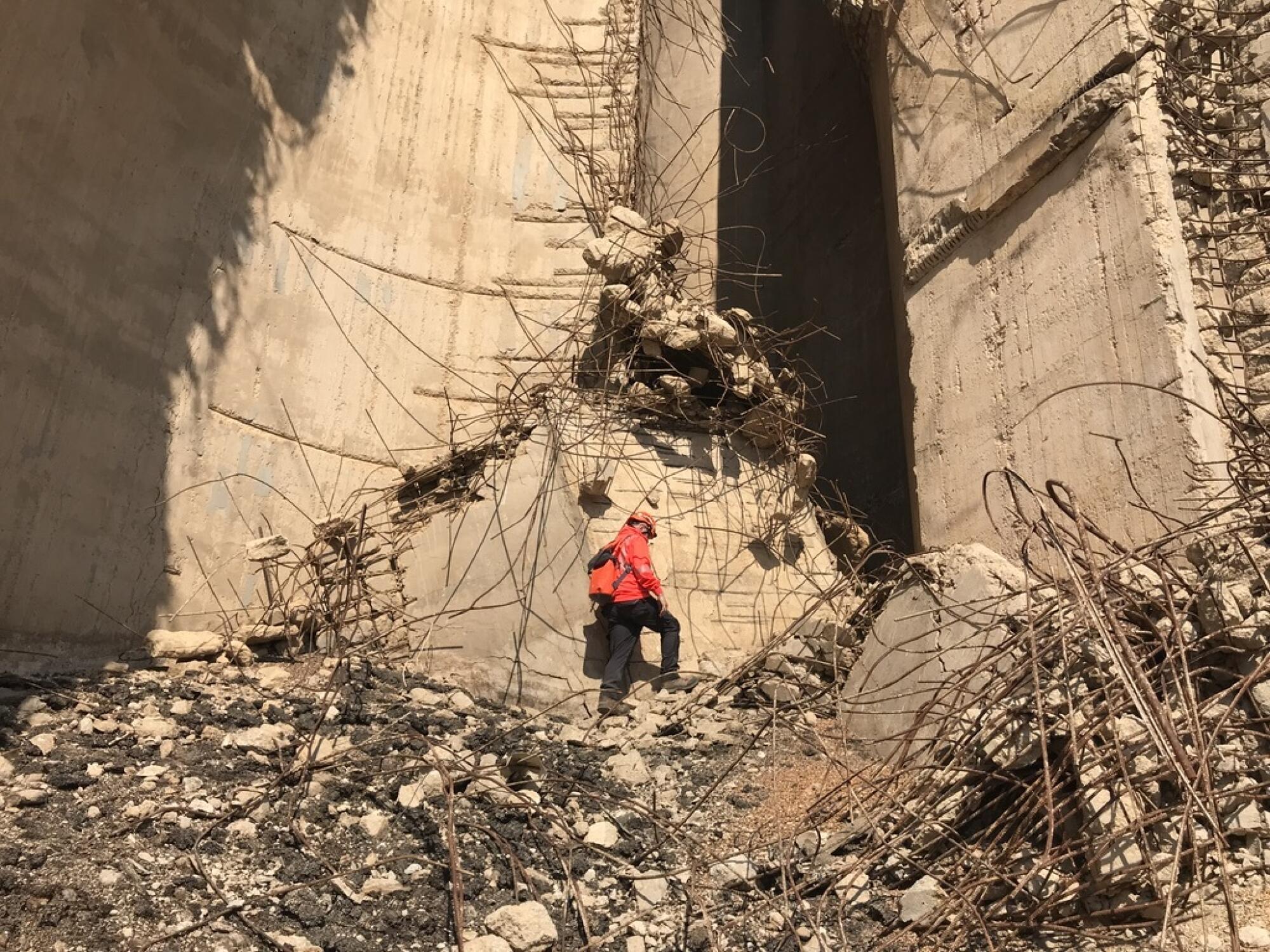
When the shock wave smacked into the 48 silos, it vaporized the closest of the three rows of storage cylinders.
“That was like the front line,” said Emmanuel Durand, a French civil engineer and silo expert who has spent months analyzing the surviving cylinders.
The damaged silos disgorged tens of thousands of tons of grain, none of which has been removed from the port as authorities fear an environmental disaster if they dump it in the sea.
In the intervening months, subjected to the winter’s rains and the summer’s humidity and heat, the grain has not only rotted but also fermented, with mounds of the stuff generating temperatures in excess of 194 degrees. Its nauseating miasma attracts phalanxes of rats and pigeons; the latter swarm at all hours around the skeletal remains of the silos.
Durand installed tiltmeters on the surviving silos and ran dozens of laser scans on the site. Roughly half of the cylinders are shifting and could collapse at any moment.
“It’s like a volcano. You can’t predict how it’s going to fall. You just have to keep on monitoring,” Durand said, adding that the northern block of cylinders had leaned 16.5 inches since the explosion.
Lebanon’s caretaker prime minister says he was shocked to learn he was being charged with negligence in the Aug. 4 port explosion.
By comparison, before Italian authorities repaired Pisa’s famous leaning tower, its pitch increased less than 0.2 of an inch per year, Durand said.
Rebuilding anything as large as the silos on the site is impossible, he said. They had been built on land reclaimed from the sea, with thousands of piles driven into the seabed to create the necessary foundations. Many of those piles are now broken, and the ground can’t take new ones.
Plans to demolish the silos have yet to be firmed up, but several ideas to refurbish the area have emerged. An ambitious German proposal, which the federal government in Berlin has supported to the tune of $11.8 million and is led by Hamburg Port Consulting, would move port operations to another part of the shore and transform the current area into a new neighborhood.
That has spurred fears of a repeat of a so-called Solidere scenario, when former warlords-turned-politicians commandeered downtown Beirut after Lebanon’s 15-year civil war, expelled its residents and created glitzy Dubai-style shopping boulevards out of keeping with the neighborhood. The area became known as Solidere, after the Lebanese real-estate company created to develop the district after the war.
News Alerts
Get breaking news, investigations, analysis and more signature journalism from the Los Angeles Times in your inbox.
You may occasionally receive promotional content from the Los Angeles Times.
“There are many people in civil society who don’t want this event to be disregarded,” Mona Hallak, an architect and preservation activist, said of the port explosion. “It’s a painful event, one that cannot be part of a real-estate project that forgets about it.”
Suheil Mahayni, who heads Hamburg Port Consulting, said his proposal could yield some $2.5 billion in profits through international investors, while modernizing and making port operations more efficient.
It would mean demolishing the silos, he said, but the results would be worth it and open the site to the public.
“Why not build something in the port area that is not a ghetto for the rich but something which finances everything, including the rebuilding of the port and the 300,000 destroyed homes?” Mahayni said. He added that a key requirement would be that the funds go into a trust, with no access to by the government so as to ensure transparency and that funds would be used solely for investment in the port and refurbishment of the city.
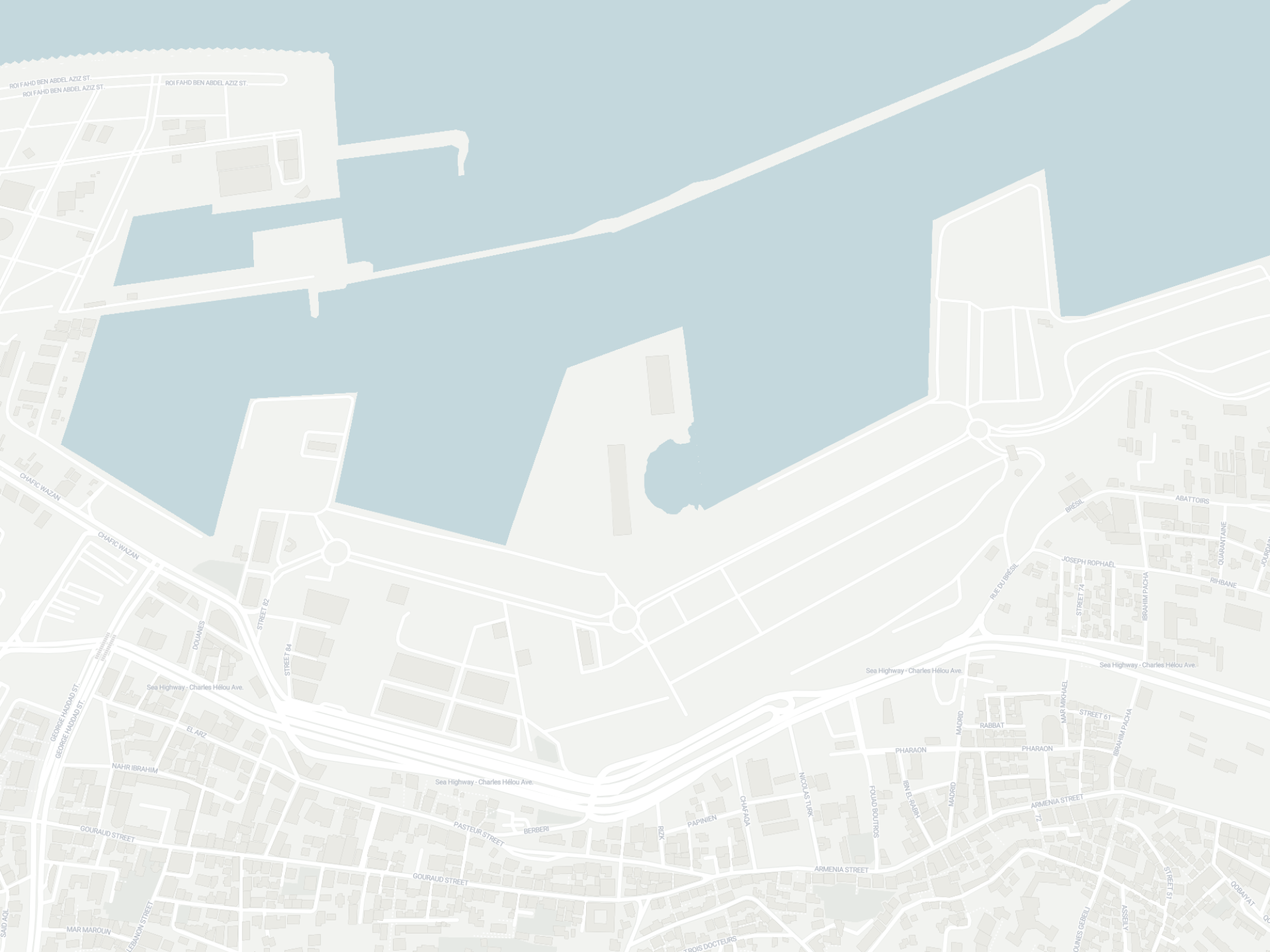
Yet that’s likely to be a nonstarter for a notoriously rapacious Lebanese political class. On Monday, Gebran Bassil, who heads the country’s largest Christian party, the Free Patriotic Movement, tweeted a proposal to establish a state-owned company that would own, invest in and manage the port with international and Lebanese partners.
“Haven’t you stolen enough off of people’s blood?” said one of hundreds of replies excoriating Bassil’s idea.
For all the damage it caused, the blast proved to be only one step in Lebanon’s continued unraveling. Each week since has brought a fresh humiliation, a new obstacle to living a normal life. The Lebanese lira, now one-tenth of its value just two years ago, seems as worthless as Monopoly money. The trappings of a functional state — electricity, traffic lights, fuel — hang by a thread. The government that resigned after the port explosion has yet to be replaced.
Shortages of basic goods have hit Lebanon as its leaders do little to resolve a long-running currency crisis that has sparked despair and desperation.
As the blast anniversary approached, various attempts at a memorial seemed only to highlight, in almost ludicrous terms, the unequal suffering caused by the explosion. One jewelry designer created the “Silo Bag,” a gold-plated clutch “handcrafted with the glass shattered” in the disaster. A group of DJs signed on to play for a pool party set for the day before the anniversary of the explosion; the shindig was called “The Blast.” (It was canceled after a backlash on social media.)
Then there’s “The Gesture,” a giant sculpture of a figure with a phoenix in its hand made by Lebanese artist Nadim Karam out of steel recovered from the port site. The statue, which Karam installed this week after getting support from government officials, enraged many Lebanese, including Atallah, the urban designer.
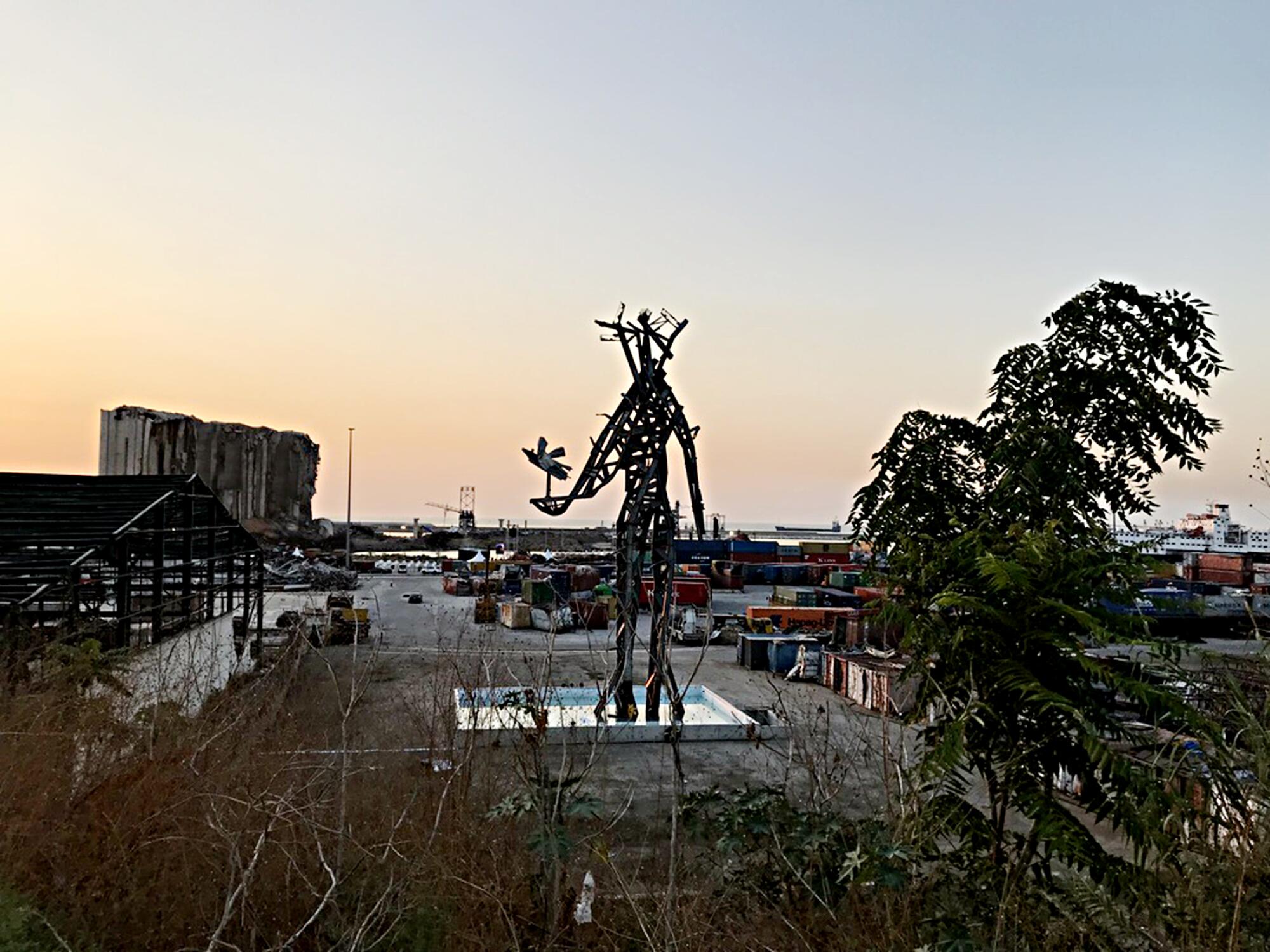
“A monument that commemorates something means you’ve moved on. But we haven’t moved on from anything, because the consequences are still there,” Atallah said. “You still have the disabled, those in shock, the homeless. Neighborhoods have barely started to emerge from the tragedy, and most importantly, the system that caused this tragedy is still present.”
Mia Atoui, a clinical psychologist who co-founded and leads Embrace, a Lebanese mental health charity, agreed, saying that she hasn’t met anyone “who feels they have processed the events of Aug. 4.”
“Till today, [at] every gathering, every meeting or social event, there isn’t a single conversation in Lebanon without mentioning it,” she said.
“It’s the stages of grief: denial, anger, negotiation, sadness, acceptance, making meaning — we’re still in between around the anger and sadness phases. When do we become ready to perceive it in a different way or make sense of it? When we’ve accepted it. When do we do that? When we know who is responsible.”
The government says a dam is necessary to provide drinking water in an era of rising temperatures and climate change. Activists say it’s another corrupt government project.
When she learned of the explosion, Ziade, the illustrator and visual artist, took out a map of Beirut and unfolded it on the floor of her Paris apartment. In May, she published an illustrated book in which she describes the moment she saw the silos after the blast.
“With the silos destroyed, everything became possible, nothing would prevent Beirut from sinking into darkness,” she wrote.
She hopes the silos will be rebuilt.
More to Read
Sign up for Essential California
The most important California stories and recommendations in your inbox every morning.
You may occasionally receive promotional content from the Los Angeles Times.
